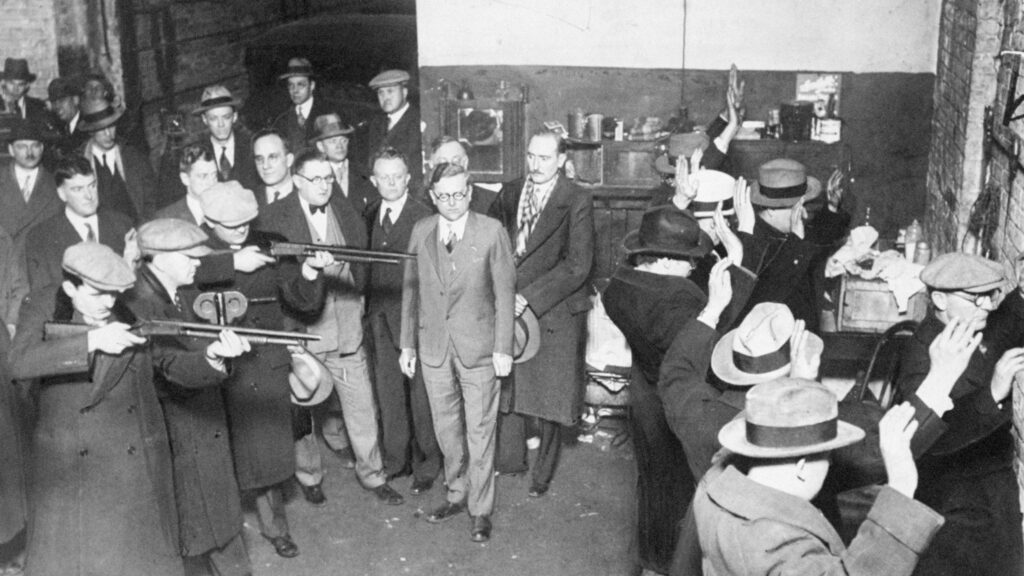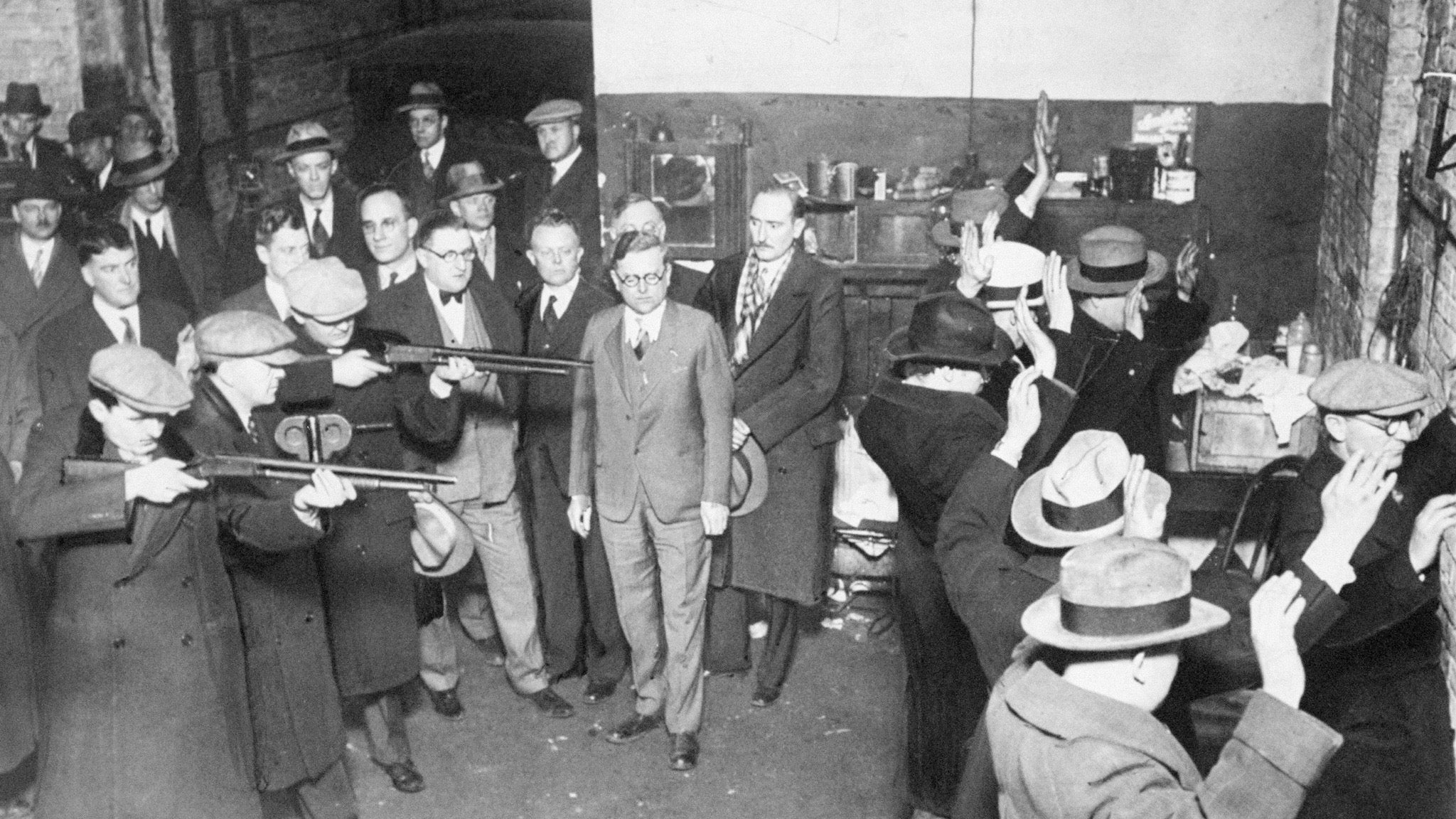

The St. Valentine’s Day Massacre shocked the world on February 14, 1929, when Chicago’s North Side erupted in gang violence. Gang warfare ruled the streets of Chicago during the late 1920s, as chief gangster Al Capone sought to consolidate control by eliminating his rivals in the illegal trades of bootlegging, gambling and prostitution. This rash of gang violence reached its bloody climax in a garage on the city’s North Side on February 14, 1929, when seven men associated with the Irish gangster George “Bugs” Moran, one of Capone’s longtime enemies, were shot to death by several men dressed as policemen. The St. Valentine’s Day Massacre, as it was known, remains an unsolved crime and was never officially linked to Capone, but he was generally considered to have been responsible for the murders.
The Rise of Scarface: Al Capone And Chicago
From 1924 to 1930, the city of Chicago gained a widespread reputation for lawlessness and violence. Not coincidentally, this phenomenon coincided with the reign of chief crime lord Al “Scarface” Capone, who took over from his boss Johnny Torrio in 1925. (Torrio, who was seriously wounded in an assassination attempt in 1924, had “retired” to Brooklyn.) Prohibition, ushered in by the passage of the 18th Amendment in 1920, had greatly increased the earnings of America’s gangsters through bootlegging (the illegal manufacture and sale of alcohol) and speakeasies (illicit drinking establishments), as well as gambling and prostitution. Capone’s income from these activities was estimated at some $60 million a year; his net worth in 1927 was around $100 million.
Did you know? George “Bugs” Moran was on his way to the garage in Chicago at the time of the St. Valentine’s Day Massacre; he missed getting killed by minutes. A few days later, he told reporters “Only Capone kills like that.” Reached at his Florida home for comment on the murders, Capone offered his own opinion: “The only man who kills like that is Bugs Moran.”
Over the years, Al Capone consolidated control over most of Chicago’s crime rackets by ruthlessly gunning down his rivals. In 1924, authorities counted some 16 gang-related murders; this brand of slaying continued until 1929, reaching a high of 64 murders in one year during that time. Federal authorities, including the Federal Bureau of Investigation, had much less jurisdiction than they have today, and did not include Chicago’s gang-related activity.
READ MORE: How the Prohibition Era Spurred Organized Crime
Massacre on St. Valentine’s Day
Chicago’s gang war reached its bloody climax in the so-called St. Valentine’s Day Massacre of 1929. One of Capone’s longtime enemies, the Irish gangster George “Bugs” Moran, ran his bootlegging operations out of a garage at 2122 North Clark Street. On February 14, seven members of Moran’s operation were gunned down while standing lined up, facing the wall of the garage. Some 70 rounds of ammunition were fired. When police officers from Chicago’s 36th District arrived, they found one gang member, Frank Gusenberg, barely alive. In the few minutes before he died, they pressed him to reveal what had happened, but Gusenberg wouldn’t talk.
Police could find only a few eyewitnesses, but eventually concluded that gunmen dressed as police officers had entered the garage and pretended to be arresting the men. Though Moran and others immediately blamed the massacre on Capone’s gang, the famous gangster himself claimed to have been at his home in Florida at the time. No one was ever brought to trial for the murders. It remains one of the biggest unsolved crimes in history.
The Downfall of Public Enemy No. 1
Though the St. Valentine’s Day Massacre marked the end of any significant gang opposition to Capone’s rule in Chicago, it can also be said to have marked the beginning of his downfall. With his highly effective organization, his impressive income and his willingness to ruthlessly eliminate his rivals, Capone had become the country’s most notorious gangster, and the newspapers dubbed him “Public Enemy No. 1.” Federal authorities began investigating Capone after he failed to appear before a federal grand jury after being subpoenaed in March 1929. When he finally appeared and testified, federal agents arrested him for contempt of court. Capone posted bond and was released, only to be arrested in Philadelphia that May on charges of carrying concealed weapons. Capone served nine months in prison and was released for good behavior.
In February 1931, a federal court found Capone guilty on the contempt charge and sentenced him to six months in Cook County Jail. Meanwhile, the U.S. Treasury Department had launched an investigation of Capone for income tax evasion. Through diligent forensic accounting, Special Agent Frank Wilson and other members of the Intelligence Unit of the Internal Revenue Service were able to put together a case, and in June 1931 Capone was indicted for evasion of federal income tax. Convicted that October after an internationally publicized trial, Capone was sentenced to 11 years in prison, first in Atlanta and later at Alcatraz. He was released in 1939 and died an invalid recluse at his Florida home in 1947.